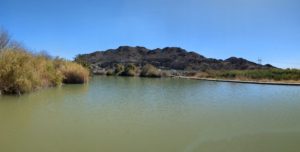
Betty’s Kitchen Watchable Wildlife Area and Interpretive Trail
Nestled between Mittry Lake, Laguna Dam, and the Colorado River; this recreation area includes riparian areas with two cottonwood/willow plantations that attract a variety of bird life.
Betty’s Kitchen Watchable Wildlife Area and Interpretive Trail
Nestled between Mittry Lake, Laguna Dam, and the Colorado River; this recreation area includes riparian areas with two cottonwood/willow plantations that attract a variety of bird life.
Cibola National Wildlife Refuge
An 18,444-acre refuge that was designated to protect and recreate the marshes, backwaters, and meanders that historically provided wintering grounds for migratory waterfowl and other wildlife that natural flooding would have formed.
Cibola Valley Conservation Area
First developed to create habitat for the "Southwestern" Willow Flycatcher, the Yellow-billed Cuckoo, and other endangered species. The area consists of agricultural fields and undeveloped land planted with native vegetation to restore cottonwood-willow, mesquite, and desert upland habitat types.
East Wetlands Park
This area is a combination of wetlands, the Colorado River and side channels, riparian corridors, mesquite and cottonwood groves, and surrounding agricultural fields.
Fortuna Pond
A man made pond south of the Gila River that is surrounded by cottonwoods, willows, mesquites, tamarisks, and quail bush.
Imperial Dam
Imperial Dam is located on the south side of the Imperial Reservoir, which is designated as an Arizona Important Birding Area (IBA). The Colorado River bisects the Reservoir and it is important as a wintering area for Canada geese and many species of ducks. Imperial Dam Long Term Visitor Area (LTVA) campground is approximately 3,500 ... Read more
Imperial National Wildlife Refuge
The refuge protects 30 miles of Colorado River wildlife habitt and serves as an important stopover point for migratory birds on the Pacific Flyway, making it a popular destination for birdwatching.
Laguna Division Conservation Area
A 1,200-acre conservation area set aside to recover endangered, threatened, and sensitive species along the Lower Colorado River.
Martinez Lake – Fisher’s Landing
The lake is good for a variety of ducks, mergansers, gulls, and terns. Osprey are year-round residents and joined in winter by harriers and falcons.
Mittry Lake
This area is a magnet for resident and migrating birds. From the Mittry Lake Overlook, there is a view over a watery marsh that is good for hearing Common Moorhen, American Coot, Least Bittern, Virginia Rail, and Sora.
Palm Canyon in Kofa National Wildlife Refuge
The last place in Arizona where native California palm trees grow in their natural habitat. Birds are numerous most of the year in Palm Canyon.
West Wetlands Park
This 110-acre park is located along the Colorado River within the Yuma Crossing National Heritage Area. Burrowing owl habitat is maintained and there is a viewing platform to allow for public observation.

Nestled between Mittry Lake, Laguna Dam, and the Colorado River; this recreation area includes riparian areas with two cottonwood/willow plantations that attract a variety of bird life.
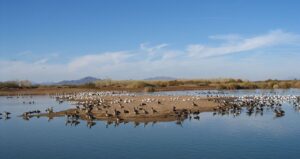
An 18,444-acre refuge that was designated to protect and recreate the marshes, backwaters, and meanders that historically provided wintering grounds for migratory waterfowl and other wildlife that natural flooding would have formed.

First developed to create habitat for the “Southwestern” Willow Flycatcher, the Yellow-billed Cuckoo, and other endangered species. The area consists of agricultural fields and undeveloped land planted with native vegetation to restore cottonwood-willow, mesquite, and desert upland habitat types.
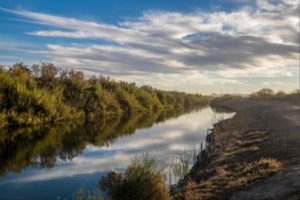
This area is a combination of wetlands, the Colorado River and side channels, riparian corridors, mesquite and cottonwood groves, and surrounding agricultural fields.

A man made pond south of the Gila River that is surrounded by cottonwoods, willows, mesquites, tamarisks, and quail bush.
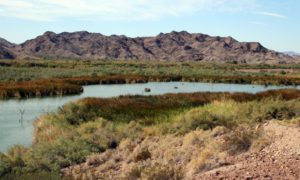
Imperial Dam is located on the south side of the Imperial Reservoir, which is designated as an Arizona Important Birding Area (IBA). The Colorado River bisects the Reservoir and it is important as a wintering area for Canada geese and many species of ducks. Imperial Dam Long Term Visitor Area (LTVA) campground is approximately 3,500
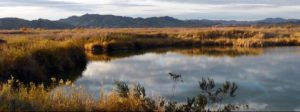
The refuge protects 30 miles of Colorado River wildlife habitt and serves as an important stopover point for migratory birds on the Pacific Flyway, making it a popular destination for birdwatching.

A 1,200-acre conservation area set aside to recover endangered, threatened, and sensitive species along the Lower Colorado River.
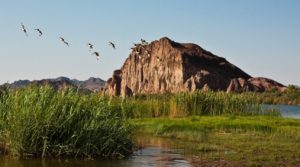
The lake is good for a variety of ducks, mergansers, gulls, and terns. Osprey are year-round residents and joined in winter by harriers and falcons.

This area is a magnet for resident and migrating birds. From the Mittry Lake Overlook, there is a view over a watery marsh that is good for hearing Common Moorhen, American Coot, Least Bittern, Virginia Rail, and Sora.

The last place in Arizona where native California palm trees grow in their natural habitat. Birds are numerous most of the year in Palm Canyon.
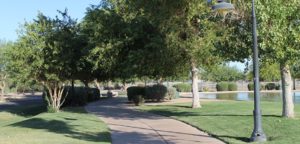
This 110-acre park is located along the Colorado River within the Yuma Crossing National Heritage Area. Burrowing owl habitat is maintained and there is a viewing platform to allow for public observation.

The Arizona Birding Trail is a network of more than 300 birding and watchable wildlife sites across the state. Whether you are a newcomer or an experienced birder, the Arizona Birding Trail is your guide to adventure!
© 2024 Arizona Birding Trail